NURSING PNN101
Marshalltown Community College
Page 3 out of 28 results
Sort by
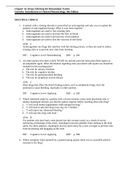
-
Chapter 14: Drugs Affecting the Hematologic System Visovsky: Introduction to Clinical Pharmacology, 9th Edition
- Exam (elaborations) • 10 pages • 2022
- Available in package deal
-
- $9.49
- + learn more
1. A patient with a clotting disorder is prescribed an anticoagulant and asks you to explain the purpose of anticoagulant therapy. What is your best response? a. Anticoagulants are used to lyse existing clots. b. Anticoagulants are used to increase the flow of blood. c. Anticoagulants are used to prevent new clot formation. d. Anticoagulants are used to thin the viscosity of the blood. ANS: C Anticoagulants are drugs that interfere with the clotting process, so they are used to reduce ex...
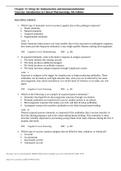
-
NURSING PNN101 Chapter 15: Drugs for Immunization and Immunomodulation Visovsky: Introduction to Clinical Pharmacology, 9th Edition
- Exam (elaborations) • 6 pages • 2022
- Available in package deal
-
- $8.49
- 1x sold
- + learn more
1. Which type of immunity serves to protect against day-to-day pathogen exposure? a. Innate immunity b. Natural immunity c. Acquired immunity d. Supplemental immunity ANS: A Innate immunity helps protect you from smaller day-to-day exposures to pathogenic organism but cannot provide long-term immunity to any single specific disease-causing microorganism. DIF: Cognitive Level: Remembering REF: p. 280 2. In acquired immunity, what is the body’s response to antigen exposure? a. The body...
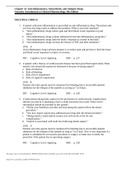
-
Chapter 12: Anti-inflammatory, Antiarthritis, and Antigout Drugs Visovsky: Introduction to Clinical Pharmacology, 9th Edition
- Exam (elaborations) • 9 pages • 2022
- Available in package deal
-
- $8.49
- + learn more
1. A patient with joint inflammation is prescribed an anti-inflammatory drug. The patient asks you how this drug works to address this problem. What is your best response? a. “Anti-inflammatory drugs reduce pain and limit blood vessel responses to joint injury.” b. “Anti-inflammatory drugs contain antibacterial and anti-inflammatory properties.” c. “Anti-inflammatory drugs limit the body’s response to cortisol in the body.” d. “Anti-inflammatory drugs increase the release o...
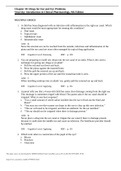
-
Chapter 18: Drugs for Ear and Eye Problems Vislosky: Introduction to Clinical Pharmacology, 9th Edition
- Exam (elaborations) • 6 pages • 2022
- Available in package deal
-
- $10.49
- + learn more
1. A child has been diagnosed with an infection with inflammation in the right ear canal. Which drug route would be most appropriate for treating this condition? a. Oral route b. Topical route c. Ophthalmic route d. Intramuscular route ANS: B Since the external ear can be reached from the outside, infections and inflammation of the pinna and the ear canal are most often managed by topical drug application. DIF: Cognitive Level: Knowing REF: p. 330 2. You are preparing to instill otic d...
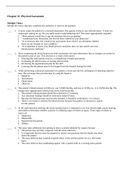
-
NURSING PNN101>Chapter 21. Physical Assessment question and answers
- Exam (elaborations) • 30 pages • 2022
- Available in package deal
-
- $10.49
- + learn more
1. A nurse wakes the patient for a focused assessment. The patient, trying to rest, tells the nurse, “I wish you would quit waking me up. Do you really need to keep bothering me?” The nurse appropriately responds: 1. “Most patients would love to get the attention that you are getting.” 2. “I understand your frustration, but this has been ordered by your physician.” 3. “It is necessary that I do a head-to-toe assessment from which I can determine whether there are any changes i...
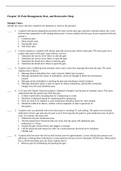
-
Chapter 19. Pain Management, Rest, and Restorative Sleep
- Exam (elaborations) • 15 pages • 2022
- Available in package deal
-
- $9.49
- + learn more
Identify the choice that best completes the statement or answers the question. ____ 1. A patient who had an amputation just below the knee several days ago expresses confusion about why a foot that has been amputated is still causing intense pain. A nurse explains that the type of pain experienced by the patient is 1. Cutaneous pain. 2. Deep somatic pain. 3. Neuropathic pain. 4. Soft-tissue pain. ____ 2. A nurse explains to a patient with chronic pain that exercise may relieve some pain....
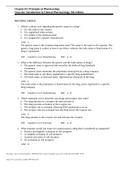
-
Chapter 03: Principles of Pharmacology Visovsky: Introduction to Clinical Pharmacology, 9th Edition
- Exam (elaborations) • 7 pages • 2022
-
- $9.49
- + learn more
1. Which is always true regarding the generic name for a drug? a. It is the same in any country. b. It is capitalized when written. c. It is similar to the chemical name. d. It is assigned by a specific manufacturer. ANS: A The generic name is the common drug name used. This name is the same in all countries. The generic drug name is written in lower-case letters, whereas the trade name or brand name of a drug is capitalized. DIF: Cognitive Level: Remembering REF: p. 23 2. What is the ...
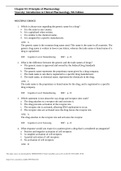
-
Chapter 03: Principles of Pharmacology Visovsky: Introduction to Clinical Pharmacology, 9th Edition
- Exam (elaborations) • 7 pages • 2022
-
- $9.49
- + learn more
1. Which is always true regarding the generic name for a drug? a. It is the same in any country. b. It is capitalized when written. c. It is similar to the chemical name. d. It is assigned by a specific manufacturer. ANS: A The generic name is the common drug name used. This name is the same in all countries. The generic drug name is written in lower-case letters, whereas the trade name or brand name of a drug is capitalized. DIF: Cognitive Level: Remembering REF: p. 23 2. What is the ...

Do you wonder why so many students wear nice clothes, have money to spare and enjoy tons of free time? Well, they sell on Stuvia! Imagine your study notes being downloaded a dozen times for $15 each. Every. Single. Day. Discover all about earning on Stuvia


